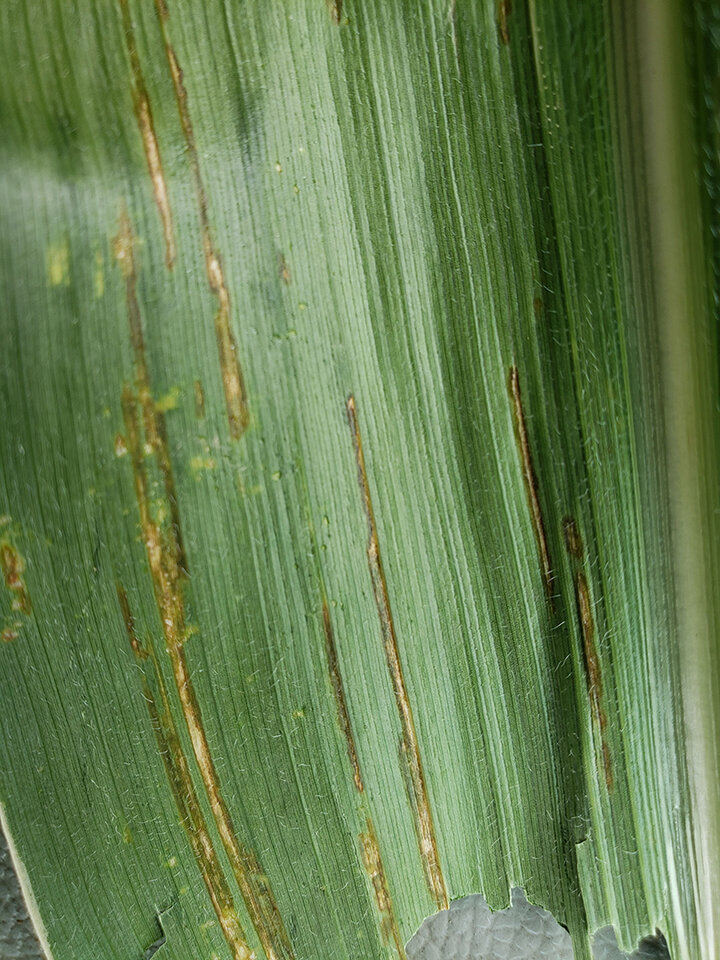A few diseases have begun in corn fields in Nebraska. Frequent rainfall in recent weeks favored disease development and spread of plant pathogens. Some of those diseases are only becoming evident (visible) now. Dry and hot weather conditions could help to slow most diseases. In addition, frequent irrigation may also support disease development and spread. Thus, it’s important to scout corn for diseases and continue to scout regularly.
Tar Spot
Tar spot (Figure 1) has been confirmed on samples this season in several counties in eastern Nebraska and in surrounding states (Figure 2). Tar spot pressure is still very low in most areas, but beginning to increase in others where there’s a history of more disease. It’s important to remember that the tar spot fungus disease cycle requires an average of two to three weeks before symptoms are visible to us after infection. Thus, we may continue to see tar spot development in the coming days, even in spite of hot temperatures, from infections that occurred during the last two to three weeks when conditions were more favorable.
Figure 2. Active tar spot infections are highlighted in yellow. (Zoom enabled)Symptoms
The tar spot fungus produces small black spots (reproductive structures called stromata) on upper leaf surfaces. Spots will eventually appear black underneath on the bottom side of leaves too, and will continue to grow larger and elongate along leaf veins. A few spots may also have tan rings around them. But, black spots are common on corn leaves right now and are often insect frass instead of tar spot. Insect frass can be very difficult to distinguish from tar spot and can lead to costly misdiagnoses. The tar spot fungus is embedded in the leaf and can’t be wiped off like insect frass, so be sure to wet and firmly rub black spots on leaves before calling it tar spot and making treatment decisions.

Management
Corn hybrids vary in their reaction to tar spot, thus selecting hybrids with better disease ratings (indicating more resistance) can help reduce disease severity. During the growing season, application of foliar fungicides can be effective at managing the disease when applied at appropriate time(s). Fungicides with a mixture of active ingredients from two or more fungicide classes provided the best control of tar spot. Results further showed that products applied once between VT (full tassel emergence) through R3 (milk) when disease pressure was low (less than 5% on the ear leaf) were effective controlling tar spot during most years. It’s important to continue scouting regularly to monitor tar spot and other disease changes to make timely treatment decisions. See the Crop Protection Network for more information, including the recent article about managing tar spot.
What to Expect Next
Tar spot will likely continue to develop in eastern Nebraska counties, especially in irrigated fields, albeit slower during hot, dry weather. The disease is known for increasing more rapidly during the latter grain fill stages, so expect it to increase more later in the season. It’s likely that the distribution of the fungus and tar spot will continue to expand, both locally as the fungus increases in an area and especially to fields and counties further west. Diseased samples are needed to confirm the disease in new areas.
Other Diseases
Some other diseases are active in Nebraska corn fields right now, too. Bacterial leaf streak, also worsened by wet conditions, has been surprisingly aggressive in some fields. It’s important that you can recognize the difference between this disease and the common fungal disease, gray leaf spot (GLS) that is also active in the lower leaves of some fields.
Southern rust has been confirmed in several Kansas counties, including in northeast Kansas. Fields in southern Nebraska should also be monitored closely for southern rust in the coming days/weeks.
Common rust has also been noted in many Nebraska fields this year following the frequent and widespread rain. The color of some common rust pustules appeared more orange than the typical brick red/brown, making them appear more similar to southern rust and more difficulty to differentiate.


Resources
Monitor tar spot and other disease development in fields and notify your local county Nebraska Extension team member or the UNL Plant and Pest Diagnostic Clinic if you need help identifying a disease before making a management decision.

